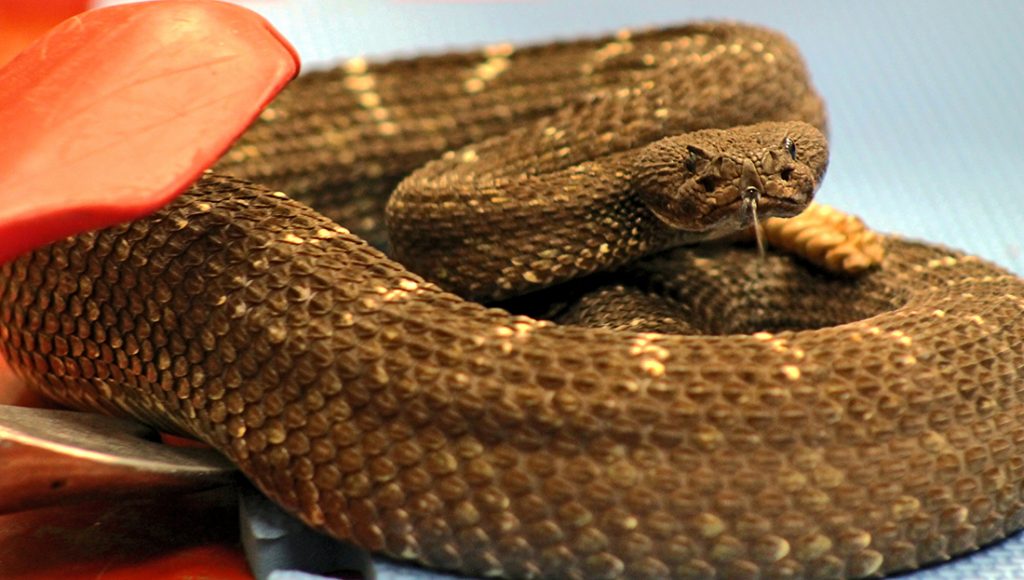By Heidi Toth
NAU Communications
The shoebox rattles loudly and consistently as Erika Nowak eases it onto the floor.
Using 3-foot-long tongs, Nowak, an assistant research professor in the School of Earth and Sustainability at Northern Arizona University and the Department of Biological Sciences and a herpetologist with the Colorado Plateau Research Station, grasps the box lid and lifts it up. Every move is slow and controlled.
Once the lid is up, it’s easy to see why. The Mojave rattlesnake curled up in the box is rattling its tail so fast it appears blurry, sending the well-known message: Go away.
The budding biologists around it, though, simply lean in closer as Nowak walks them through how to handle the snake to protect both it and themselves. Don’t squeeze the tongs too tightly, but you need enough pressure to get a firm grip on the snake. Don’t get too close to the head, but close enough that you can maneuver the long body into the snake bucket. Even when it’s in there, keep an eye on its head. Snakes can jump.
For Nowak, this is a normal part of her day. She’s been working with rattlesnakes and other types of snakes for more than 30 years, studying them to aid in knowledge and conservation and using her affection for the animals to educate other people. In the process, she’s made something of a name for herself as champion of some of the country’s most vulnerable reptiles.
Nowak’s work was recently highlighted in “American Snakes,” a book by Sean Graham that looks at the species of snakes throughout the country and the researchers who have dedicated their lives to studying the creatures. In it, Nowak talks about a formative experience that led to her love of snakes: While 10-year-old Erika was playing outside her upstate New York home, she came across two harmless snakes, watched them for a moment, then killed them. She knew as soon as it she’d done it that it was wrong, a feeling her father confirmed when he came outside and saw her holding a shovel over the dead snakes.
“My dad looked at me, and he was utterly disgusted, and he said, ‘What did you do that for?’ He had never spoken to me in that tone of voice before,” she said. “I had no answer. I had done something that is completely horrible, and I had no explanation.”
Motivated by a desire to protect snakes, she entered herpetology, becoming one of only about a dozen women at that time to study venomous snakes. As her career has progressed, that has changed, and she’s surrounded by other women herpetologists now. Her motivation, however, has remained the same: She wants to learn from these animals to help protect them while also helping to recover the population.
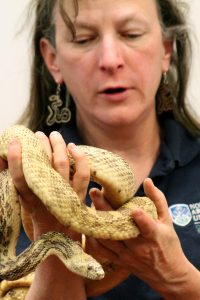
Nowak now primarily studies two types of snakes: narrow-headed gartersnakes and rattlesnakes. Although both types of animal face unique challenges, she worries the broad changes the planet is seeing will hurt all snakes in the future. Reptiles and amphibians are likely to be in a uniquely different situation as the Earth continues to warm, Nowak said. They are ectotherms (formerly called “cold-blooded”), so at first glance, a warmer atmosphere should be better for these species. But many of them still live in places with a winter that’s cold enough to require these animals to become inactive, even if the cold temperatures are less consistent or not as frequent as they used to be. Most of these snakes aren’t accustomed to hibernating on and off for the winter.
“The problem is, if you make that period warmer but still have some really cold times, you’re basically encouraging animals that have to hibernate to burn up all their fat reserves, so they may starve to death or die of dehydration during warmer winters, when it’s warm enough that they’re using up their fat reserves but still not warm enough to hunt,” she said. “Hibernating reptiles, I think, will disproportionately suffer with climate change.”
Add to that increased development and other human activity encroaching on snakes’ territory, the introduction of invasive species into habitats and a human fear of snakes that is incredibly disproportionate to the actual danger snakes present humans, and it’s enough to keep Nowak worried for the creatures she loves.
“Many species are facing extinction or at least are threatened because of human actions,” Nowak said.
Studying the last, best population of narrow-headed gartersnakes
The “last, best population in the world” of narrow-headed gartersnakes lives in upper Oak Creek. While there are a few other populations in northern Arizona and into New Mexico, many are so much smaller than this one that they’re hard to measure, Nowak said.
She started studying this species almost accidentally; when Nowak finished her master’s degree, with a focus on rattlesnakes, the Arizona Game and Fish Department asked for proposals to study the distribution of narrow-headed gartersnakes in Oak Creek; biologists were concerned the population was shrinking and were considering it for listing on the endangered species list. Nowak put in a proposal.
All snakes are subject to some of the same hazards: predators (including humans), a changing climate that alters their environment, disease. But narrow-headed gartersnakes seemed particularly at risk, exhibiting greater susceptibility to diseases, possibly because of lack of genetic diversity after years of inbreeding. The increase in human recreational activity may also have contributed, introducing foreign pathogens as well as killing more snakes.
“They see humans as predators, so we think they’re avoiding being visible as much as they used to be,” she said.
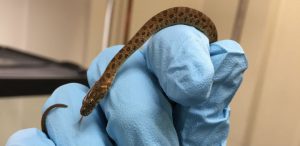
In 2007, wild narrow-headed gartersnakes were captured from Oak Creek and the Black River and brought into captivity in an attempt to establish breeding programs. Many of the captured snakes died, but the Phoenix Zoo was successful in breeding a litter, and a few of those came to NAU, Nowak said. These animals that were born in captivity were hardier and better able to survive; they were even able to breed a litter of their own.
In 2014, many organizations and individuals came together to capture juvenile narrow-headed gartersnakes in an attempt to save the species from possible extinction after the Slide Fire caused flooding in Oak Creek. These snakes were intended to start a new captive breeding program specifically for the Oak Creek population. Although these individuals also proved challenging to keep in captivity, in 2016, 11 babies were born in NAU’s gartersnake vivarium. This enclosure, designed to be as like the wild as possible, was funded by the NAU Green Fund, along with state, federal and private donors, and is unique among captive breeding programs for snakes, as it is based on a university campus, with animal care and research accomplished primarily by students.
Master’s student Kayla Lauger, who was in Nowak’s snake-handling training, is leading the charge on some of that research. She is studying the effects of different husbandry practices on the stress levels of the snakes. She measures the levels of corticosterone, a hormone that increases due to stress, in the snakes’ shed skin and feces, which is non-invasive. Lauger also is compiling basic information about the snakes like creating a basic blood profile and a general baseline of health for gartersnakes. Scientists have these data for many animals, Nowak said, but because narrow-headed gartersnakes are rare and isolated to small areas, less of this type of research has been done of the species.
“The federally threatened status of the species means that there are captive recovery programs to preserve genetic diversity and ensure we have reservoirs of this species should declines continue in the wild, but it’s important to understand how captivity affects the snakes,” Lauger said. “Because reptiles are behaviorally pretty subtle, I’m looking directly at their physiology by measuring stress hormones to gauge how they react to different conditions they’re exposed to in captivity.
“The ultimate goal here is to have a research-based understanding of how these snakes respond to captivity so we can keep them healthy and happy in recovery programs.”
Lauger’s best moment in her research—when one of the snakes gave birth to a litter, a first for the NAU colony—was replicated last month, when another female narrow-headed gartersnake gave birth to 12 healthy babies in the NAU vivarium. Matthew Salanga, assistant professor in the Department of Biological Sciences, assisted with providing live zebrafish for the babies’ first meals. Following a one- to two-year headstarting period, the gartersnakes will be released into the wild or enter captive breeding programs to assist with species recovery. Because they will be raised in captivity, Nowak said, Lauger’s research about stress is even more important because they have to teach snakes how to survive in the wild, avoiding predators. Some of that work includes assessing ways to make the snakes nervous and avoidant of predators, including humans. Knowing they should be afraid of other species will help protect the snakes.
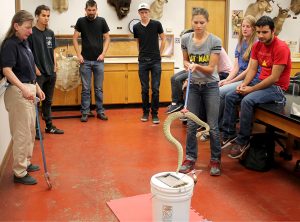
“We want them to be habituated enough right now, but we encourage them to not be so friendly with humans,” Nowak said. “We’ll encourage them to be scared.”
As she watches these snakes grow, Nowak continues to seek out snakes in Oak Creek with increasing concern. Although she can’t say definitively that the population in Oak Creek is shrinking, she is counting fewer snakes. It’s possible the snakes are hiding better, she says, but the consistent decline in counts leads her to consider the first likelihood is greater.
“Based on these types of trends showing up across the range, it’s probably more than any observer effect,” she said. “I think there is something going on with the population itself.”
Myth-busting the stereotypes of rattlesnakes
This venomous snake is Nowak’s first love. As a master’s student, she studied the National Parks Service’s practice of translocation—moving the snakes out of the parks to reduce human-snake interaction without killing the snakes. Unfortunately, they often ended up dead anyway. Rattlesnakes in Arizona normally have a home range of about a square mile. Move them to a new location miles away, and the snakes fared badly.
“The dominant focus of an animal that’s translocated outside of its home range is, for most species, to try to return home,” Nowak said. “And when that fails, they don’t do very well.”
The more Nowak studied rattlesnakes, the more she learned that much of the common knowledge about the reptile was simply wrong. Rattlesnakes, which can live for 30-50 years in the wild, weren’t attracted to food and water left out for birds, as many people believed. Rattlers aren’t aggressive animals; instead, they preferred to avoid humans and stay out of sight, defending themselves only when they were startled or attacked themselves. They didn’t fight each other over territory; dozens of rattlesnakes can live in the same range, reducing the rodent population in the region by as much as a third. The slithering introverts wanted to hunt rodents, birds and rabbits in their home range and be left alone. The difficulty came as humans increasingly came into that range, either through developments or tourism, like the national parks, and brought with them a disproportionate fear of snakes.
To that end, educating people about snakes has become part of Nowak’s research mission. After her early work, NPS stopped translocating rattlesnakes out of the park; instead, if hikers came across the snakes on trails, a ranger would pick it up and move it 10 to 100 feet away from the trail—still inside its comfort zone but far from human activity. Hikers who see rattlesnakes should never try to pick them up or even get close; instead, Nowak said, slow down, move gently and without sudden movements and move away from or around the snake.
In other words, leave the snake alone, and it will leave you alone. Do not, under any circumstances, pick up the snake or try to kill it. Many snakebites come when someone is trying to kill a snake, usually using a rock to beat it to death, which is inhumane to the snake, unnecessary for public safety and dangerous to the person doing it. (As an aside, it is illegal to kill snakes in national parks. They are a resource of the park and thus protected by the federal government.)
“They’re not ankle-biters,” Nowak said. “They’re biting the people who are attacking them. They’re defending themselves.”
Nowak also runs trainings on how to handle snakes for people whose jobs occasionally bring them into contact with rattlesnakes, such as utility workers, park workers and even the owners of a local winery, who find snakes in their vineyard. They talk about best practices in moving snakes, which may be necessary for people in these lines of work, but Nowak’s focus remains on handling the snake in a humane and safe way.
Granted, Nowak is a little biased in favor of snakes. She has a government-issued permit to own certain types of snakes, and she’s collected several who were illegally collected by poachers, born in captivity or otherwise cannot live outdoors. They live in large terrariums in her home, occasionally coming with her to classes, trainings and science fairs. They had a few outings in June, including a snake-handling class for a dozen of Nowak’s herpetology students. She walks them through the rattlesnake facts, laying the groundwork for an important lesson in dealing with snakes: you don’t need to be afraid of them, but respecting them and their space is critical.
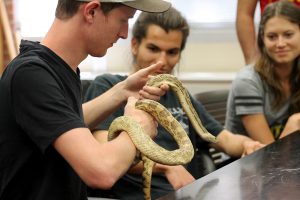
None of the students in the training that day have that problem. They don’t start off with rattlesnakes; Nowak first removes a gophersnake from its enclosure, demonstrating how to support its head and body and make sure the snake was comfortable and not scared. (Gophersnakes are not venomous, but bacteria on human skin could be dangerous to a snake. Also, a snake bite will hurt.) As the students pass the 5-foot-long yellow and brown snake around, she pulls a colorful Sonoran mountain kingsnake, allowing it to move through her fingers as the class discussed the mimicry between the harmless kingsnake and the venomous coral snake.
Then, armed with tongs and a snake bucket, she opens the cage for the first rattlesnake, talking over the rattling as she demonstrates how to handle it. Unfazed, student after student gently grasp the snake with the tongs and safely deposit it in the bucket. When the Mojave got tired, a feisty Arizona black rattlesnake takes its place. It is a good-looking snake.
All this being said, Nowak reminds the class, only pick up the snake if you absolutely must.
“Humans are predators,” she said simply. “If you encounter a snake in the wild, the best thing you can do is not touch it. Just leave it alone.”
